| Back Number | No.26 (Final Issue) 2005/10/12 |
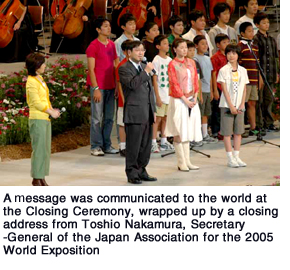 EXPO 2005 Aichi, Japan, which opened on March 25, completed its 185-day run on September 25 without incident after drawing approximately 22.05 million visitors, exceeding original expectations of 15 million visitors.
EXPO 2005 Aichi, Japan, which opened on March 25, completed its 185-day run on September 25 without incident after drawing approximately 22.05 million visitors, exceeding original expectations of 15 million visitors.As communicated in the Closing Ceremony, the 185 days of this first international exhibition of the 21st century were those for bringing forth blossoms of the future and having them bear fruit. This EXPO was the starting point for a relay that goes beyond generations for the resolution of global issues. What kind of an international exhibition was EXPO 2005 Aichi, Japan? What was the message it presented to the future and to the world? At this conclusion of the EXPO, let us look back and confirm. |
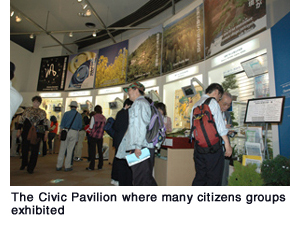 On June 8, 1994, the 115th Session of the General Assembly of the International Exhibitions Bureau (Bureau International des Expositions: BIE) adopted the resolution that future exhibitions have “a commitment to the supreme importance for Humanity of due respect for Nature and the environment,” deciding the future direction of international exhibitions of the 21st century as the forum for resolving global issues. EXPO 2005 Aichi, Japan became the first exhibition to realize this BIE vision. In other words, EXPO 2005 was one in which countries exhibited, shared wisdom, cooperated and addressed issues with a common goal of resolving global issues. While exhibitors of past international exhibitions were countries and commercial enterprises, this was the first international exhibition that saw the participation of citizens groups. The EXPO realized a state in which governments, companies and citizens worked as one in order to address global issues.
On June 8, 1994, the 115th Session of the General Assembly of the International Exhibitions Bureau (Bureau International des Expositions: BIE) adopted the resolution that future exhibitions have “a commitment to the supreme importance for Humanity of due respect for Nature and the environment,” deciding the future direction of international exhibitions of the 21st century as the forum for resolving global issues. EXPO 2005 Aichi, Japan became the first exhibition to realize this BIE vision. In other words, EXPO 2005 was one in which countries exhibited, shared wisdom, cooperated and addressed issues with a common goal of resolving global issues. While exhibitors of past international exhibitions were countries and commercial enterprises, this was the first international exhibition that saw the participation of citizens groups. The EXPO realized a state in which governments, companies and citizens worked as one in order to address global issues. |
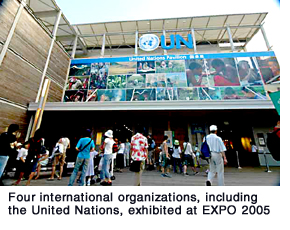 EXPO 2005 included participation by many developing countries, and as an international exhibition held in Japan, a record number of 121 countries took part. Four international organizations - the United Nations, International Tropical Timber Organization, Organization for Economic Co-operation and Development, and the International Red Cross and Red Crescent Movement - also participated.
EXPO 2005 included participation by many developing countries, and as an international exhibition held in Japan, a record number of 121 countries took part. Four international organizations - the United Nations, International Tropical Timber Organization, Organization for Economic Co-operation and Development, and the International Red Cross and Red Crescent Movement - also participated.Included in the resolutions adopted by the 115th Session of the General Assembly was that “each exhibition must have a modern theme corresponding to the expectations of contemporary society” and that the theme “should give ample scope for a presentation of state-of-the-art scientific, technological and economical progress made in the area chosen, while giving due consideration to the dichotomy existing between human and social aspirations on the one hand and the necessary protection of the natural environment on the other.” In this sense, “Nature’s Wisdom,” the theme of EXPO 2005 can be said to have fulfilled the BIE's conditions regarding the themes of international exhibitions. This theme was not only the underlying concept behind the exhibits presented at each pavilion but also deepened through various conferences held during the EXPO, including the EXPO 2005 International Forums, the first serial symposium in international exhibition history which was held seven times under the common theme “Creation of Sustainable Society.” Furthermore, the “Nature’s Wisdom Award” was presented to pavilions which well expressed the “Nature’s Wisdom” theme based on criteria such as the quality of the interior and exterior décor, their relevance to the theme, and the messages communicated. The last time awards were given to pavilions in an international exhibition was at the 1958 World Exposition in Brussels. The medal system was revived for EXPO 2005 after nearly half a century. The BIE’s General Assembly, in the 137th Session held on June 24 while EXPO 2005 Aichi, Japan was taking place, made a “Declaration of Congratulations and Praise” for EXPO 2005. The adoption of a resolution such as this by the BIE General Assembly is without precedent. |
|
What kind of an international exhibition was EXPO 2005? Let us take a look at some figures <Number of Visitors> Total number: 22,049,544 people (original target: 15 million) Average number of visitors per day: 119,187 people Number of Foreign Visitors (Based on surveys of foreign visitors conducted by the Japan Association for the 2005 World Exhibition; survey conducted five times between June and September 2005; the following data are weighted averages based on the five surveys)
|
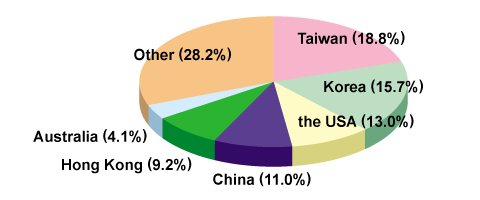 |
| <Number of Foreign VIPs> Head of state level: 48; Ministerial level: 195; Other VIPs: 268 <Average Stay> 6 hours 55 minutes <Visitor Satisfaction> Positive assessment from 80% of all visitors (based on visitor surveys conducted by the Japan Association for the 2005 World Exhibition) |
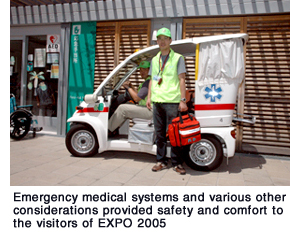 While EXPO 2005 saw a greater than expected number of visitors, satisfaction of their visit to the EXPO was quite high. In addition to the good content of the exhibits, one cannot ignore the fact that the comfort of the venue and security was secured through the good showing of the staff members and volunteers making full use of information technology and the improvement efforts carried out on a daily basis. For example, the average number of lost children assisted per 100,000 visitors was 2.6, far lower than past international exhibitions.
While EXPO 2005 saw a greater than expected number of visitors, satisfaction of their visit to the EXPO was quite high. In addition to the good content of the exhibits, one cannot ignore the fact that the comfort of the venue and security was secured through the good showing of the staff members and volunteers making full use of information technology and the improvement efforts carried out on a daily basis. For example, the average number of lost children assisted per 100,000 visitors was 2.6, far lower than past international exhibitions. |
| <Number of Members from the Foreign Media> Visited by approximately 1,800 members of the press from about 380 media organizations of roughly 75 countries The message expressed by EXPO 2005 Aichi, Japan was communicated to the world by the many members of the foreign press that visited this EXPO. |
 What then did EXPO 2005 achieve towards the goal of resolving global issues? What then did EXPO 2005 achieve towards the goal of resolving global issues?First, this EXPO presented concrete solutions for the global issue of environmental conservation. One of them was to show that advanced technology can be of use in resolving global issues. |
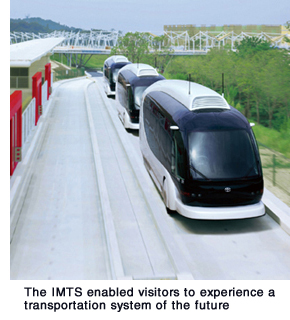 Visitors were able to experience first-hand the results of fuel cells that operate through methane fermented from the waste they generated at the venue, etc., as sources of energy, as well as visit the Japan Pavilion Nagakute where all of the electrical power was supplied by new power generation systems, including the solar power system which could be seen at various points of the EXPO venue. When they stopped for food or beverages at various facilities, they used biodegradable-plastic eating utensils born through environmental technology. The world-class greening wall (Bio-lung) that they saw at the venue was a technology for suppressing the heat-island effect seen in urban areas. And, the Intelligent Multimode Transit System (IMTS) used as a mode of transport within the Nagakute Area, and the fuel cell hybrid bus that linked the Nagakute Area and the Seto Area, offered visitors a chance to ride on safe, comfortable and environmentally-friendly modes of transport of the future. In other words, visitors to EXPO 2005 were able to experience, one step ahead of the rest of the world, a society of the future brought about by state-of-the-art green technology. At the same time, this EXPO was a valuable opportunity that provided an arena for proving tests of these new technologies. The various state-of-the-art technologies tested at EXPO 2005 will most likely be put into practical application in the near future and play major roles towards the resolution of environmental issues.
Visitors were able to experience first-hand the results of fuel cells that operate through methane fermented from the waste they generated at the venue, etc., as sources of energy, as well as visit the Japan Pavilion Nagakute where all of the electrical power was supplied by new power generation systems, including the solar power system which could be seen at various points of the EXPO venue. When they stopped for food or beverages at various facilities, they used biodegradable-plastic eating utensils born through environmental technology. The world-class greening wall (Bio-lung) that they saw at the venue was a technology for suppressing the heat-island effect seen in urban areas. And, the Intelligent Multimode Transit System (IMTS) used as a mode of transport within the Nagakute Area, and the fuel cell hybrid bus that linked the Nagakute Area and the Seto Area, offered visitors a chance to ride on safe, comfortable and environmentally-friendly modes of transport of the future. In other words, visitors to EXPO 2005 were able to experience, one step ahead of the rest of the world, a society of the future brought about by state-of-the-art green technology. At the same time, this EXPO was a valuable opportunity that provided an arena for proving tests of these new technologies. The various state-of-the-art technologies tested at EXPO 2005 will most likely be put into practical application in the near future and play major roles towards the resolution of environmental issues. |
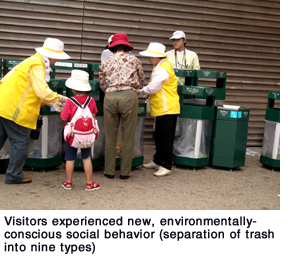 The second concrete solution presented by EXPO 2005 Aichi, Japan towards the global issue of environmental protection is that it adopted new social behavior and systems that take consideration of nature and the environment.
The second concrete solution presented by EXPO 2005 Aichi, Japan towards the global issue of environmental protection is that it adopted new social behavior and systems that take consideration of nature and the environment.Visitors were most likely refreshed by seeing the venue with not a single bit of litter. At the same time, despite a bit of confusion on their part, they experienced, with the help of sanitation staff and volunteers, the separation of their trash into nine different types. And, there are more than a few people who went through first-time experiences, such as donating towards forest protection like afforestation through the EXPO Eco-Money Project in which environmentally-responsible behavior, including the reduction of the use of plastic shopping bags, earned Eco-Money points. |
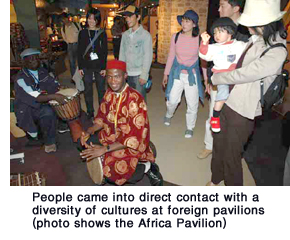 In addition to presenting concrete solutions, another achievement of EXPO 2005 is that it created a sense of solidarity for the resolution of global issues. The people who visited the pavilions of foreign countries and came directly into contact not only with exhibits but also the people of the various countries were most likely able to feel that they are living as part of a world filled with diverse races, cultures, societies and histories. At the same time, there were probably many that felt strong solidarity and emotional ties towards the gathering of hearts and wisdom born from the nature, histories and cultures of each country, for the global issue of environmental protection.
In addition to presenting concrete solutions, another achievement of EXPO 2005 is that it created a sense of solidarity for the resolution of global issues. The people who visited the pavilions of foreign countries and came directly into contact not only with exhibits but also the people of the various countries were most likely able to feel that they are living as part of a world filled with diverse races, cultures, societies and histories. At the same time, there were probably many that felt strong solidarity and emotional ties towards the gathering of hearts and wisdom born from the nature, histories and cultures of each country, for the global issue of environmental protection. |
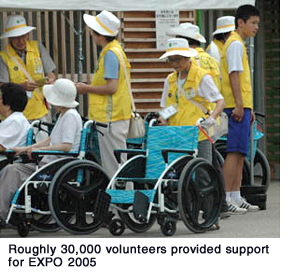 The introduction of the activities of the United Nations and related organizations not only resulted in deep empathy towards those who are dedicated to bringing about happiness to the people of the world but also brewed a desire among many to contribute to the world. More than 50,000 messages were left by people who waited hours to repeatedly enter the International Red Cross & Red Crescent Pavilion. They included, “I want to help Red Cross activities after I retire,” and “I want to become a nurse and save the people of the world.” This was a sense of togetherness that was born because EXPO 2005 was an international exhibition that was held with a theme and goal that is shared by humanity.
The introduction of the activities of the United Nations and related organizations not only resulted in deep empathy towards those who are dedicated to bringing about happiness to the people of the world but also brewed a desire among many to contribute to the world. More than 50,000 messages were left by people who waited hours to repeatedly enter the International Red Cross & Red Crescent Pavilion. They included, “I want to help Red Cross activities after I retire,” and “I want to become a nurse and save the people of the world.” This was a sense of togetherness that was born because EXPO 2005 was an international exhibition that was held with a theme and goal that is shared by humanity.The sight of the EXPO's 30,000 or so volunteers and the exhibits by the 30 NGO units and 235 citizens groups brought home the fact to each visitor that there was something that they could do for the resolution of global-scale issues. Many visitors were struck at seeing volunteers working hard to help visitors separate their trash or accompanying disabled visitors to help them move about the venue. There were also many visitors that were surprised to find out, upon visiting exhibits of NGOs involved in environmental conservation and other activities, that there were already those around them who were carrying out such efforts. The fact that many visitors were able to learn that they themselves could participate in such activities and take part in the resolution of global issues if they took just one step forward can also be said to be an achievement of EXPO 2005 Aichi, Japan. |
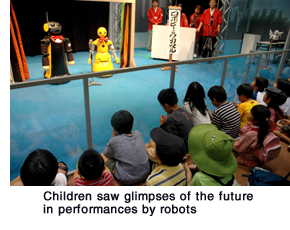 EXPO 2005 Aichi, Japan was an international exhibition that was very conscious of presenting a message to the youths and children that will be bearing the future of the world. 73 municipalities within Aichi Prefecture participated in the Aichi International Campaign for Hometown Interchange and Hospitality (AICHI Hospitality) program as “hometowns” to further international exchange. Many municipalities included the dishes of various countries in school lunches or held exchange events in order to further understanding of their “partner countries.” Once the EXPO began, they visited the pavilions of their partner countries, supported their National Days, and created opportunities for further experiences. EXPO 2005 can be said to have been a forum for international exchange that children will never forget.
EXPO 2005 Aichi, Japan was an international exhibition that was very conscious of presenting a message to the youths and children that will be bearing the future of the world. 73 municipalities within Aichi Prefecture participated in the Aichi International Campaign for Hometown Interchange and Hospitality (AICHI Hospitality) program as “hometowns” to further international exchange. Many municipalities included the dishes of various countries in school lunches or held exchange events in order to further understanding of their “partner countries.” Once the EXPO began, they visited the pavilions of their partner countries, supported their National Days, and created opportunities for further experiences. EXPO 2005 can be said to have been a forum for international exchange that children will never forget.Visits to Wanpaku Treasure Island, a pavilion for families and elementary school children themed around food and fun and the show featuring dinosaur robots, playtime with PaPeRo, the childcare robot, and the Robot Station that offered an opportunity for children to see robots at work in receiving visitors, security or cleanup were especially popular among many children. |
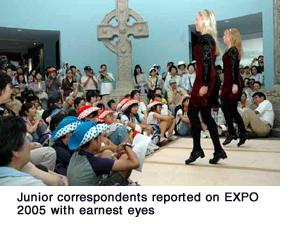 In the Nature Experience Program, “interpreters” who acted as field guides while translating the voices of nature enabled children to feel even closer to nature. And the sight of bright-eyed children climbing a tree for the first time at the Growing Village is also something that people will not forget.
In the Nature Experience Program, “interpreters” who acted as field guides while translating the voices of nature enabled children to feel even closer to nature. And the sight of bright-eyed children climbing a tree for the first time at the Growing Village is also something that people will not forget.The Kids Eco Tour was one in which volunteers led about 10 children each to various structures and sites within the EXPO 2005 venue that took consideration of the environment. The children, who saw the results of new energy technologies, like the power generation plant using raw garbage as an energy source, and environmental technology such as the Bio-lung, were most likely able to experience efforts addressing environmental issues even more concretely. The workshop for producing a newspaper in which junior correspondents visited EXPO 2005 events and edited their own newspaper saw the participation of about 6,200 children from 61 schools of 35 municipalities. EXPO 2005 Aichi, Japan was probably deeply engraved in the hearts of the children who seriously tackled the reporting of this EXPO, including interviews with Jacques Chirac, the President of France, and Japanese Prime Minister Junichiro Koizumi. The newspapers that they created will remind children of their experiences at EXPO 2005 throughout their lives. There were also many elementary and middle school students that visited the EXPO as part of an outside-school curriculum. According to a survey of 671 children and youths between the ages of 13 and 19, more than 90% respondent that they were able to experience, understand and hoped to take part in the areas of “advanced technology,” “new social systems,” “international exchange” and “participation by citizens.” Each child who visited EXPO 2005 Aichi, Japan accepted the seed sowed by the EXPO with certainty. We are certain that these seeds will bloom and bear a wealth of fruit through these children. |
 |
| EXPO 2005 AICHI, JAPAN Newsletter | |
| To read past issues:Back Number | |
| Editor/Publisher: Japan Association for
the 2005 World Exposition Head Office: 1533-1 Ibaragabasama, Nagakute-cho Aichi 480-1101 Japan Nagoya Office: Nagoya Daiya II Bldg 4F, 3-15-1 Meieki Nakamura-ku, Nagoya, Aichi 450-0002 Japan Tokyo Office: Iino Bldg 8F, 2-1-1 Uchisaiwai-cho Chiyoda-ku, Tokyo 100-0011 Japan |
 |
© Japan Association for the 2005 World Exposition
